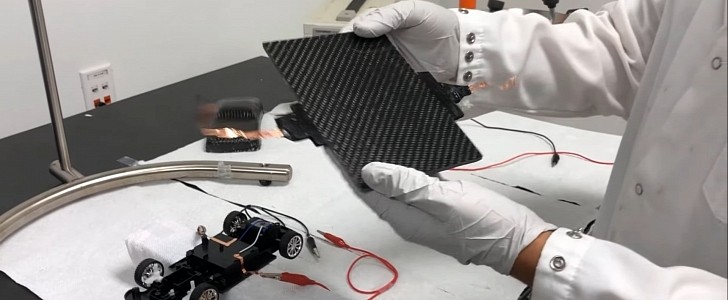An old idea to use a layered carbon composite material as an energy-storing device gets a fresh spin with the help of NASA technologies. The supercapacitor-battery hybrid material would be like a “power suit that is as strong as steel and lighter than aluminum.” Apart from acting like a strong exoskeleton or car body, the power suit can boost a car’s battery power.
A team of researchers at the University of Central Florida and NASA’s Kennedy Space Center found a way around the problem with the past approaches of “car body as an energy storage device”. The new composite materials are nontoxic and nonflammable, which is paramount to passenger safety in case of accidents. Same as with composite body panels, the material can withstand an auto collision, having a significant tensile strength.
The layered composite material would act as both a battery and a capacitor, with very quick charge and discharge rates. In an electric vehicle, this would allow for nearly-instantaneously charging using brake energy regeneration or normal charging. According to the researchers that worked on the project, the material, when used as a car body shell, could increase an EV's range by 25%. As a supercapacitor, it would also boost the power allowing for insane acceleration performances.
“Our idea is to use the body shells to store energy to supplement the power stored in batteries,” says study co-author Jayan Thomas, the team leader and a professor in UCF’s NanoScience Technology Center and Department of Materials Science and Engineering. “The advantage is that this composite can reduce the weight of your car and increase the miles per charge,” he says. “It is as strong as or even stronger than steel but much lighter.”
The supercapacitor-battery hybrid is made out of a sandwich of carbon-fiber layers, alternating the negative with the positive. The carbon fiber layers have nanoscale graphene sheets attached, while the electrodes have metal oxides deposited on them, allowing for energy storage ability. The material is also said to be very durable, with a lifecycle 10 times longer than that of Li-Ion batteries currently used in electric vehicles.
The technology has yet to be tested in a real environment, and the researchers speak of a “level five” technology readiness. Level nine would be the last one before moving into commercial production. Until then, it would require additional development and testing focused on commercial applications
The layered composite material would act as both a battery and a capacitor, with very quick charge and discharge rates. In an electric vehicle, this would allow for nearly-instantaneously charging using brake energy regeneration or normal charging. According to the researchers that worked on the project, the material, when used as a car body shell, could increase an EV's range by 25%. As a supercapacitor, it would also boost the power allowing for insane acceleration performances.
“Our idea is to use the body shells to store energy to supplement the power stored in batteries,” says study co-author Jayan Thomas, the team leader and a professor in UCF’s NanoScience Technology Center and Department of Materials Science and Engineering. “The advantage is that this composite can reduce the weight of your car and increase the miles per charge,” he says. “It is as strong as or even stronger than steel but much lighter.”
The supercapacitor-battery hybrid is made out of a sandwich of carbon-fiber layers, alternating the negative with the positive. The carbon fiber layers have nanoscale graphene sheets attached, while the electrodes have metal oxides deposited on them, allowing for energy storage ability. The material is also said to be very durable, with a lifecycle 10 times longer than that of Li-Ion batteries currently used in electric vehicles.
The technology has yet to be tested in a real environment, and the researchers speak of a “level five” technology readiness. Level nine would be the last one before moving into commercial production. Until then, it would require additional development and testing focused on commercial applications









